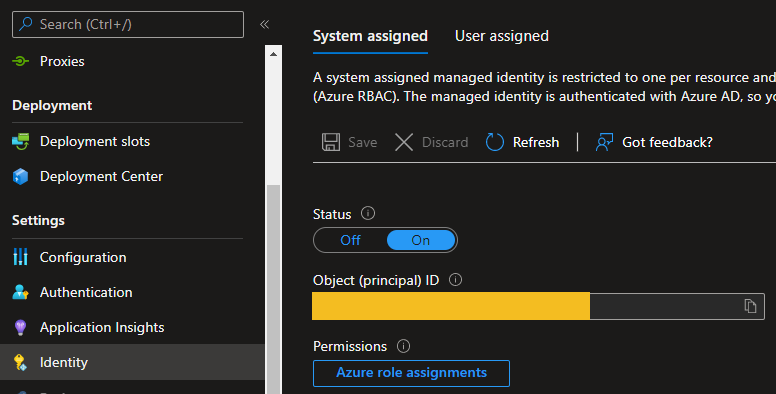Authenticate to Microsoft Graph from Azure Functions
In this blog post I will show you how to authenticate to Microsoft Graph inside of a PowerShell Azure Function. We will use a System Assigned Managed identity for authentication.
To enable a System Assigned Managed identity inside of an Azure Function go to the Identity section, switch the status to on and Save. The result should be like this:
For Authentication to Microsoft Graph we can use the following environment variables:
- IDENTITY_ENDPOINT / MSI_ENDPOINT: The URL to call to get a token for the Managed Service identity
- IDENTITY_HEADER: The object id for the Managed Service identity in Azure AD
Now we can use the following PowerShell code to authenticate to Microsoft Graph and get an access token:
1
2
3
4
5
6
7
8
9
10
11
12
$resource = 'https://graph.microsoft.com'
$endpoint = $env:IDENTITY_ENDPOINT
$header = $env:IDENTITY_HEADER
$apiVersion = '2019-08-01'
$headers = @{ 'X-Identity-Header' = $header }
$url = "$($endpoint)?api-version=$apiVersion&resource=$resource"
$response = Invoke-RestMethod -Method Get
$accessToken = $response.access_token
(optional) To use the MgGraph CmdLets inside of the Azure Function use the following PowerShell code:
If you want to use the MgGraph CmdLets inside of an Azure Function add the needed modules to the requirements.psd1 file.
1
2
3
4
5
6
$authHeader = @{
'Content-Type' = 'application/json'
'Authorization' = 'Bearer ' + $accessToken
}
Connect-MgGraph -AccessToken $accessToken
If you do not need to Authenticate to Azure through Managed Identity comment out the if statement in profile.ps1.
Now authenticated to Microsoft Graph you cannot do anything because the System Assigned managed identity has no rights inside of Microsoft Graph.
To assign them I have found a good blog article of an MVP called Luise Freese. You can find the complete article here
You essentially will need the following Az CLI commands for doing a Microsoft Graph delegated permission (Sample with the Group.Read.All permission):
If you do not know the Microsoft Graph permissions you can find the complete permission reference here
1
2
3
4
5
6
7
8
9
10
11
12
13
14
15
16
17
18
19
#Save that service provider
$graphId = az ad sp list --query "[?appDisplayName=='Microsoft Graph'].appId | [0]" --all
# Get permission scope for "Group.Read.All"
$appRoleId = az ad sp show --id $graphId --query "appRoles[?value=='Group.Read.All'].id | [0]"
#Set values
$webAppName="<your function app name>"
$principalId=$(az resource list -n $webAppName --query [*].identity.principalId --out tsv)
$graphResourceId=$(az ad sp list --display-name "Microsoft Graph" --query [0].objectId --out tsv)
$appRoleId=$(az ad sp list --display-name "Microsoft Graph" --query "[0].appRoles[?value=='Group.Read.All' && contains(allowedMemberTypes, 'Application')].id" --out tsv)
$body="{'principalId':'$principalId','resourceId':'$graphResourceId','appRoleId':'$appRoleId'}"
#the actual REST call
az rest --method post --uri https://graph.microsoft.com/v1.0/servicePrincipals/$principalId/appRoleAssignments --body $body --headers Content-Type=application/json
That’s it for this post. Thank you for reading.
